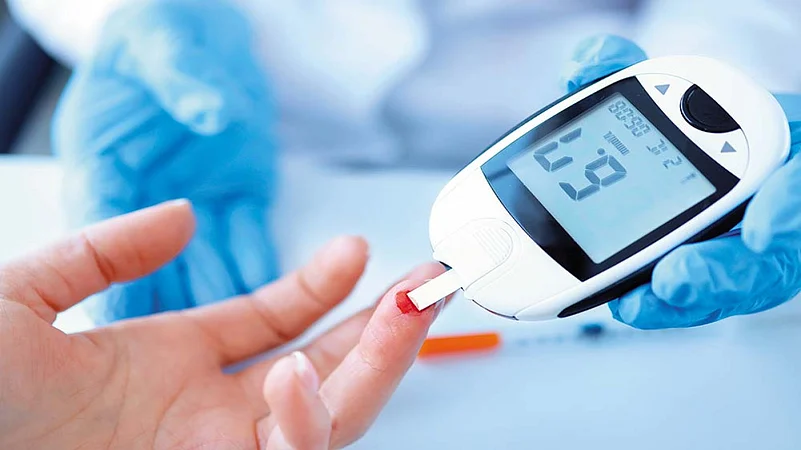The field of diabetes has undergone major transformation in this millennium. From being one of many ‘chronic’ disorders, diabetes has come to occupy centrestage in our thought process. This increasing recognition of ‘high blood sugar’ has happened for several reasons. First, the prevalence of diabetes in urban Indians has gone up from 2 per cent in the 1970s to almost 20 per cent in the metros at present. A staggering 77 million Indians—likely an underestimate—are living with diabetes. Second, the age at onset of Type II diabetes has declined over the years—people in the peak productive period of their lives are often afflicted with complications of diabetes. Third, there is growing recognition that people with well-controlled diabetes can reduce the risk of complications involving the kidney, eyes, heart, feet etc. Any public health strategy for non-communicable diseases cannot ignore diabetes.
Our understanding of diabetes too has seen considerable progress, due to incredible advances in research. Research from Pune has shown maternal malnutrition leads to in utero programming that can make the progeny prone to conditions like diabetes and obesity (epigenetics). Improving maternal nutrition by higher protein and nutrient intake can help address this issue. The prevalence of childhood obesity is rapidly increasing in India, with estimates ranging from 10 to 20 per cent. Obese children become obese adults and develop diabetes at a younger age. Obese girls are also prone to develop diabetes in pregnancy. Prevention of childhood obesity by promoting healthy food, ‘junking’ unhealthy practices and ensuring physical activity is another important component of any strategy to beat diabetes. For adults, the most powerful tool to prevent Type II diabetes is to avoid obesity. Maintaining ideal body weight through a judicious combination of healthy eating, regular physical activity and proper sleep is the rather mundane mantra to combat this. Easier said than done, though, in the crazy urban life nowadays.
What can we do after we have developed diabetes? Again, the focus is on weight reduction. Most urban Indians are clearly overweight by the time they develop Type II diabetes. The DIRECT study from the UK showed reversal of Type II diabetes within the first few years of onset by very low calorie diets. With ≥10 kg weight loss, 64 per cent of early Type II diabetes reversed. Similarly, bariatric surgery-induced weight loss and metabolic changes have been shown to reverse diabetes.
Diabetes is a fertile area for drug development. When I joined endocrinology more than three decades ago, metformin/phenformin and sulfonylureas (remember ‘Daonil’?) were the only medications available. At least six new classes of drugs have joined the party in the past two decades. These include glitazones (TZDs), gliptins (DPP4i) and the two most exciting groups—the injectable GLP1RAs (liraglutide, dulaglutide, semaglutide) and SGLT2 inhibitors (dapagliflozin, empagliflozin and others). The GLP1RAs available in India are given as a weekly or daily injection. The SGLT2 inhibitors, which work by throwing out glucose through urine, are oral preparations.

The new drugs confer no or minimal risk of hypoglycemia or low blood sugar reaction, the most dreaded fear of diabetes treatment. They require minimal dose adjustment. The GLP1RAs and SGLT2 inhibitors promote weight loss. The newest GLP1RA, semaglutide, which is available in some countries in oral form, has been reported to cause weight loss to the tune of 15 kg. Moreover, reduction in risk of heart attacks or heart failure and slowing progression of kidney disease have been striking features of SGLT2 inhibitors and to some extent GLP1RAs.
These path-breaking developments mean we now have medications for Type II diabetes that improve blood glucose without producing low blood sugar reactions, promote weight loss, and protect the heart and kidneys. However, all these drugs can have side-effects (usually minor) and need to be taken under medical advice. An interesting approach being used for future diabetes drug development works by modifying gut bacteria.
Meanwhile, there have been considerable advances on the insulin front too. Newer, genetically modified insulins mimic normal body insulin secretion very closely. Highly sophisticated delivery pumps linked to a glucose sensor (forming a closed loop, also called artificial pancreas) are increasingly being used for Type I (insulin-dependent) diabetes. Ambulatory glucose monitoring systems help in ‘micromanaging’ diabetes. Easy to use devices that can monitor blood glucose continuously are widely available now. With recent advances in understanding of the disease and such an array of powerful tools, we are now better equipped to halt the march of diabetes and its complications as we move into the post-Covid era.
ALSO READ: Diabetes Is A Bad Actor: Dr Shriram Nene
(This appeared in the print edition as "It’s Getting Better")
(The writer is chairman, Institute of Endocrinology and Diabetes, Max Healthcare. Views expressed are personal.)
















